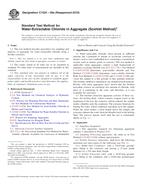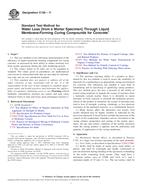Potřebujeme váš souhlas k využití jednotlivých dat, aby se vám mimo jiné mohly ukazovat informace týkající se vašich zájmů. Souhlas udělíte kliknutím na tlačítko „OK“.
ASTM C597-09
Standard Test Method for Pulse Velocity Through Concrete
Automaticky přeložený název:
Standardní zkušební metoda pro Pulse Velocity pomocí konkrétních
NORMA vydána dne 15.12.2009
Informace o normě:
Označení normy: ASTM C597-09
Poznámka: NEPLATNÁ
Datum vydání normy: 15.12.2009
Kód zboží: NS-14192
Počet stran: 4
Přibližná hmotnost: 12 g (0.03 liber)
Země: Americká technická norma
Kategorie: Technické normy ASTM
Kategorie - podobné normy:
Anotace textu normy ASTM C597-09 :
Keywords:
concrete, longitudinal stress wave, nondestructive testing, pulse velocity , ultrasonic testing, Nondestructive evaluation (NDE)--concrete/masonry, Pulse velocity, ICS Number Code 91.100.30 (Concrete and concrete products)
Doplňující informace
| Significance and Use | ||||||||
|
The pulse velocity, V, of longitudinal stress waves in a concrete mass is related to its elastic properties and density according to the following relationship: This test method is applicable to assess the uniformity and relative quality of concrete, to indicate the presence of voids and cracks, and to evaluate the effectiveness of crack repairs. It is also applicable to indicate changes in the properties of concrete, and in the survey of structures, to estimate the severity of deterioration or cracking. When used to monitor changes in condition over time, test locations are to be marked on the structure to ensure that tests are repeated at the same positions. The degree of saturation of the concrete affects the pulse velocity, and this factor must be considered when evaluating test results (Note 1). In addition, the pulse velocity in saturated concrete is less sensitive to changes in its relative quality. Note 1—The pulse velocity in saturated concrete may be up to 5 % higher than in dry concrete. The pulse velocity is independent of the dimensions of the test object provided reflected waves from boundaries do not complicate the determination of the arrival time of the directly transmitted pulse. The least dimension of the test object must exceed the wavelength of the ultrasonic vibrations (Note 2). Note 2—The wavelength of the vibrations equals the pulse velocity divided by the frequency of vibrations. For example, for a frequency of 54 kHz and a pulse velocity of 3500 m/s, the wavelength is 3500/54000 = 0.065 m. The accuracy of the measurement depends upon the ability of the operator to determine precisely the distance between the transducers and of the equipment to measure precisely the pulse transit time. The received signal strength and measured transit time are affected by the coupling of the transducers to the concrete surfaces. Sufficient coupling agent and pressure must be applied to the transducers to ensure stable transit times. The strength of the received signal is also affected by the travel path length and by the presence and degree of cracking or deterioration in the concrete tested. Note 3—Proper coupling can be verified by viewing the shape and magnitude of the received waveform. The waveform should have a decaying sinusoidal shape. The shape can be viewed by means of outputs to an oscilloscope or digitized display inherent in the device. The results obtained by the use of this test method are not to be considered as a means of measuring strength nor as an adequate test for establishing compliance of the modulus of elasticity of field concrete with that assumed in the design. The longitudinal resonance method in Test Method C215 is recommended for determining the dynamic modulus of elasticity of test specimens obtained from field concrete because Poisson's ratio does not have to be known. Note 4—When circumstances permit, a velocity-strength (or velocity-modulus) relationship may be established by the determination of pulse velocity and compressive strength (or modulus of elasticity) on a number of samples of a concrete. This relationship may serve as a basis for the estimation of strength (or modulus of elasticity) by further pulse-velocity tests on that concrete. Refer to ACI 228.1R for guidance on the procedures for developing and using such a relationship. The procedure is applicable in both field and laboratory testing regardless of size or shape of the specimen within the limitations of available pulse-generating sources. Note 5—Presently available test equipment limits path lengths to approximately 50-mm minimum and 15-m maximum, depending, in part, upon the frequency and intensity of the generated signal. The upper limit of the path length depends partly on surface conditions and partly on the characteristics of the interior concrete under investigation. A preamplifier at the receiving transducer may be used to increase the maximum path length that can be tested. The maximum path length is obtained by using transducers of relatively low resonant frequencies (20 to 30 kHz) to minimize the attenuation of the signal in the concrete. (The resonant frequency of the transducer assembly determines the frequency of vibration in the concrete.) For the shorter path lengths where loss of signal is not the governing factor, it is preferable to use resonant frequencies of 50 kHz or higher to achieve more accurate transit-time measurements and hence greater sensitivity. Since the pulse velocity in steel is up to double that in concrete, the pulse-velocity measured in the vicinity of the reinforcing steel will be higher than in plain concrete of the same composition. Where possible, avoid measurements close to steel parallel to the direction of pulse propagation. |
||||||||
| 1. Scope | ||||||||
|
1.1 This test method covers the determination of the propagation velocity of longitudinal stress wave pulses through concrete. This test method does not apply to the propagation of other types of stress waves through concrete. 1.2 The values stated in SI units are to be regarded as standard. No other units of measurement are included in this standard. 1.3 This standard does not purport to address all of the safety concerns, if any, associated with its use. It is the responsibility of the user of this standard to establish appropriate safety and health practices and determine the applicability of regulatory limitations prior to use. |
||||||||
| 2. Referenced Documents | ||||||||
|
Podobné normy:
Historická
1.10.2013
Historická
1.7.2011
Historická
1.10.2012
Historická
1.12.2010
Historická
1.10.2010
Historická
1.6.2011
Doporučujeme:
Aktualizace technických norem
Chcete mít jistotu, že používáte pouze platné technické normy?
Nabízíme Vám řešení, které Vám zajistí měsíční přehled o aktuálnosti norem, které používáte.
Chcete vědět více informací? Podívejte se na tuto stránku.



 ASTM C1436-13
ASTM C1436-13 ASTM C1451-11
ASTM C1451-11 ASTM C1480/C1480M-07..
ASTM C1480/C1480M-07.. ASTM C1524-02a(2010)..
ASTM C1524-02a(2010).. ASTM C1543-10a
ASTM C1543-10a ASTM C156-11
ASTM C156-11
 Cookies
Cookies
